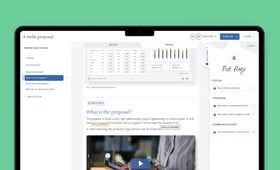
AI for board performance
From better board packs to smarter support, Artificial Intelligence is transforming board effectiveness and governance.
Artificial Intelligence (AI) is changing the teams and organisations operate — boards included. But AI’s value at board level depends on how it’s used.
At Board Intelligence, we believe that AI should aim to enhance human judgment, not replace it. Below, we explore what that looks like and how AI can drive better decision-making, more effective governance, and improved organisational performance.
Why does AI matter to board performance ?
Board performance hinges on three pillars: individuals, infrastructure, and information.
Whilst each can benefit from the use of AI, information is likely to be where the most significant gains can be achieved in the short term: according to our State of Board Effectiveness report, only 36% of directors say their board materials enable them to govern well. Not because there’s too little included, but because what they receive is unclear, unfocused, or incomplete, and getting longer every year.
AI is part of the problem, as it allows time-pressed management teams to gather, analyse, and include more and more data in their reports. But it’s also part of the solution. Used well, AI can help boards cut through that noise and get to the insight that matters — quickly, reliably, and securely.
How can AI help boards be not just more efficient but more effective too?
Getting to the insight, not just the summary
Ask ChatGPT or any other generic AI tool to summarise a report and it will stop at condensing content. Yet, the real opportunity lies in analysing the content, using AI to extract relevant insight (what the board needs to know and is already in there) as well as highlight gaps (what the boards needs to know and isn’t in there).
That’s why our Insight Driver tool doesn't simply shorten reports but maps them onto a proven in-house framework that surfaces:
- Why a report exists, and what’s the context.
- What options are under consideration, and which ones weren’t discussed.
- What impact we expect this to have, and who wasn’t considered.
- What’s being asked from the reader.
This helps board members arrive at meetings fully prepared, able to ask sharper questions, and confident they haven’t missed something important hidden deep in the document.
Helping management write better reports
It may seem counterintuitive at first: if reports get longer and worse as management teams increasingly use generative AI tools to write them, how could more AI fix the problem?
That’s because the problem isn’t with AI but with how it’s used. As explained in our guide to AI for the board pack, AI is a poor writer but a fantastic editor — and it should be used to augment report authors, not to automate them away.
That’s why our AI writing assistant, Lucia, works alongside your management team members to help them sharpen their thinking, structure their narrative, and clarify their message long before their reports reach the boardroom. It’s AI for fewer words, not more, and for better thinking, not just faster writing.
Powering smarter governance support
AI also transforms how governance professionals serve the board, helping cut down their workload so that they can better focus on things that actually move the needle.
With tools like Minute Writer, drafting accurate, timely minutes is no longer a bottleneck — just paste your notes or transcript in and out come meeting minutes ready for reviewing, alongside a list of actions that needs to be taken. Combine this with Agenda Planner to automate the management of board and committee forward agendas, and governance teams can ensure they and their board move at the speed they need.
What are the risks to look out for when adopting AI within board processes?
Adopting AI in the boardroom isn’t without its risks, but those can be managed.
Security and confidentiality are paramount. Boards deal with sensitive information, and generic AI platforms are not fit-for-purpose in this context. With our AI tools, data is neither used for training nor retained beyond its immediate use.
Trust and transparency are equally critical. Our approach is designed to put humans in control and explain what the AI does — for example, by labelling what parts of a transcript were used where when redacting minutes. Our tools never bypass human oversight; they amplify it.
What is the future of AI-powered board performance?
The future isn’t AI instead of humans — it’s AI alongside humans. As covered in our AI deep-dive webinar, we see a world where AI will:
- Elevate the board’s focus: AI will remove distractions and help boards stay locked onto the most material issues.
- Drive continuous improvement: By analysing past board packs and decisions, AI will help boards learn from patterns and refine their effectiveness over time.
- Support better stewardship: With clearer information and smarter tools, boards will be better equipped to discharge their responsibilities and deliver long-term value.
And all of this will happen while keeping directors in control, not in the dark.
How do I get started ?
AI is here, but whether it helps or hinders depends on how you use it. At Board Intelligence, we don’t just build AI tools. We build tools that make boards smarter, faster, and better informed — while keeping human judgment at the centre.
If you’re ready to put AI to work for your board, get in touch.
Want to see Board Intelligence’s software tools in action or explore how our board science experts could help to supercharge your board?
Book a demonstrationFAQs
-
Is AI going to replace board members?
No. AI supports board members by enhancing their judgment, not replacing it. It automates admin and distils insight, so humans can focus on the decisions only they can make.
-
Can I trust AI-generated insights?
When used responsibly and within secure environments — like the ones we provide — AI-generated outputs are auditable, explainable, and reliable. You remain in full control.
-
Will AI make reports longer or more complex?
Not if used properly. Our tools are designed to do the opposite: help authors express themselves clearly and concisely, and help readers access the insight they need, faster.
-
How do you ensure data security with your AI tools?
Our AI systems operate in private, ring-fenced environments. No data is shared with public models, and all usage is governed by enterprise-grade security protocols.
-
Do I need technical expertise to use these tools?
No. Our tools are intuitive and seamlessly integrated into your existing workflows. They’re designed for executives, governance professionals, and board members alike — no tech background required.


